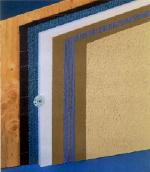Search engine visitors - click here to access entire "$ensible Home" web site
Click here to see a descriptive illustration of a wall system with exterior insulation and stucco.
Dear Jim: My house needs more wall insulation, but I do not want to lose any floor space. The exterior looks bad and needs work too. How effective is adding exterior insulation with the new stucco-like finish? - F. S.

A: Most houses more than ten years old can benefit from increasing the amount of wall insulation. Many older brick, block or masonry houses have no wall insulation at all. Increasing insulation not only lowers utility bills, but it dramatically improves indoor comfort year-round.
Adding rigid exterior insulation covered with durable synthetic stucco is also an excellent method to upgrade the exterior appearance. Synthetic stucco is available in 50 colors and many textures. The entire insulation system is called Exterior Insulation Finish System (EIFS). Some manufacturers make their systems available only through professional installers and others will sell to do-it-yourselfers.
The house exterior is a better location for insulation than inside walls. No interior floor space is lost or indoor mess created. With a masonry house, there often is no interior wall cavity in which to blow insulation.
By insulating the exterior, the entire mass of the wall materials and lumber stays at a more constant temperature. This slows indoor temperature changes throughout the day and night. The improved comfort is particularly noticeable in the summer as is a reduction in drafts in the winter.
Rigid foam insulation boards are usually just bonded with construction adhesives to the existing house exterior. Several of the systems have optional mechanical fasteners for unique applications. A simple tool installs the fastener and recesses the top. Expanded polystyrene or polyurethane foam board is often used. Polyurethane has a higher insulation value per inch thickness. The minimum foam thickness is three-quarters of an inch and most building codes limit the maximum to four inches.
Next a strong fiberglass reinforcing mesh is embedded in a thin layer of base coat material over the insulation. This adds strength to the entire insulation system and provides a smooth surface for the finish coat.
Flexible synthetic stucco is usually made from a tough acrylic polymer. Even though it is flexible for toughness, it feels hard to the touch just like real stucco. The colorant is mixed with the acrylic, so it goes all the way through the finish coating. Scratches are not apparent. The many optional textures and appearances are created by mixing various sizes of sand or aggregate.
Instant Download Update Bulletin No. 858 - listing 11 manufacturers of exterior insulation finish systems (EIFS), colors and textures (swirl, smooth, sand, stone), features, descriptions of fastening systems and complete do-it-yourself instructions for adding external insulation and stucco; manufacturers of high-efficiency insulation.
Dear Jim: I would like to upgrade my kitchen lighting to decorative 4-foot fluorescent fixtures. This will save energy and stay cooler. Do standard fluorescent lights give off much dangerous ultraviolet light? - T. U.
A: Standard fluorescent lights use about one-fourth as much electricity as incandescent bulbs for the same amount of light. Since almost all the electricity used ends up as heat, they lower your cooling costs too. Standard fluorescent lights do not give off enough ultraviolet (UV) light to be harmful. Stay away from the unshielded very high output (VHO) or super high output (SHO) fluorescents. They give off some dangerous UV-B rays.